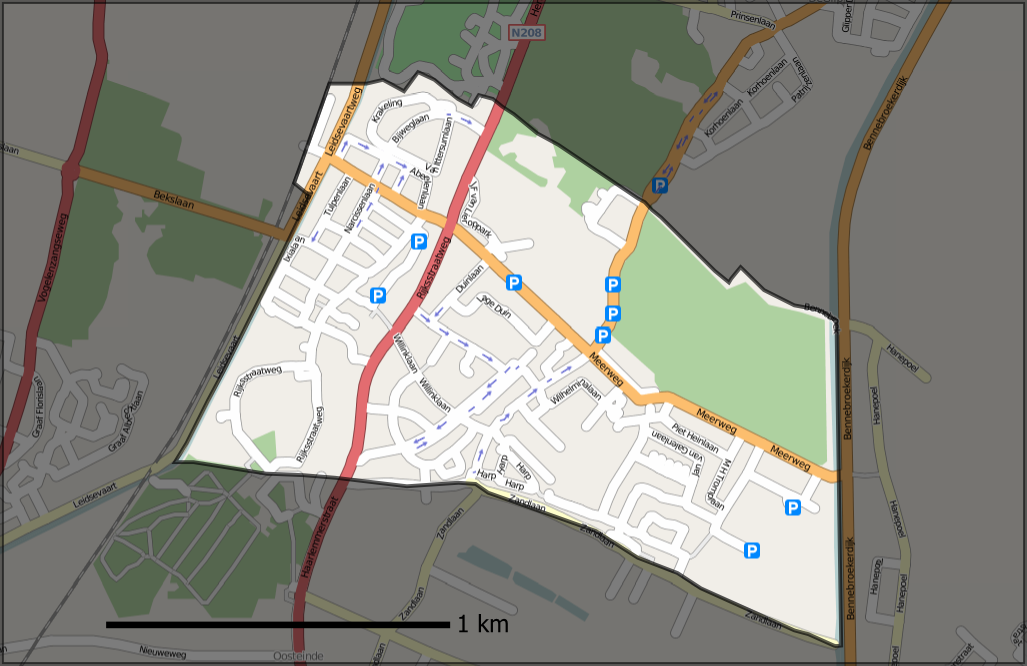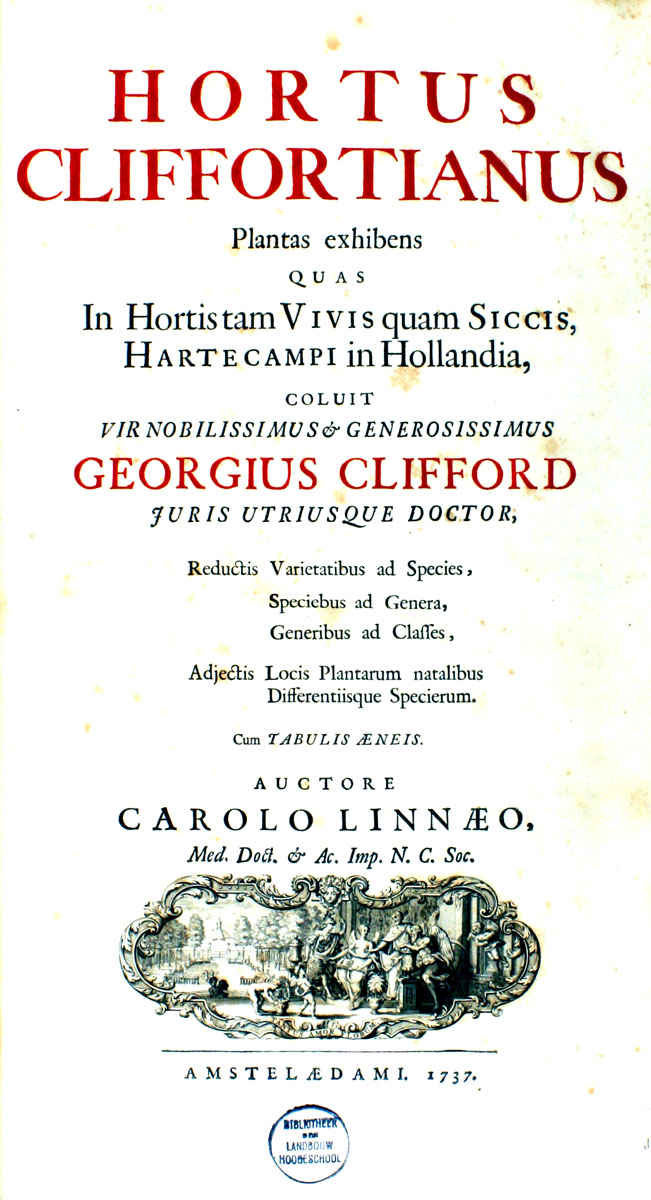|
Hartekamp
Hartekamp, or Hartecamp, is the name of a villa in Heemstede, North Holland, the Netherlands, on the Bennebroek border. It was once the Buitenplaats of George Clifford, who employed Carl Linnaeus Carl Linnaeus (23 May 1707 – 10 January 1778), also known after ennoblement in 1761 as Carl von Linné,#Blunt, Blunt (2004), p. 171. was a Swedish biologist and physician who formalised binomial nomenclature, the modern system of naming o ... in 1737 to write his '' Hortus Cliffortianus'', a detailed description of the gardens of Hartecamp. History The house was built by Johan Hinloopen in 1693Rijksmonument report who designed the basic garden and built the orangerie. It passed into Clifford's hands in 1709. The wings on either side of the main building were added after it left the Clifford family. The Clifford banking dynasty went bankrupt in 1772 and the estate went out of the family in 1788. The original editions of the ''Hortus Cliffortianus'' and other works of Linn ... [...More Info...] [...Related Items...] OR: [Wikipedia] [Google] [Baidu] |
Carl Linnaeus
Carl Linnaeus (23 May 1707 – 10 January 1778), also known after ennoblement in 1761 as Carl von Linné,#Blunt, Blunt (2004), p. 171. was a Swedish biologist and physician who formalised binomial nomenclature, the modern system of naming organisms. He is known as the "father of modern Taxonomy (biology), taxonomy". Many of his writings were in Latin; his name is rendered in Latin as and, after his 1761 ennoblement, as . Linnaeus was the son of a curate and was born in Råshult, in the countryside of Småland, southern Sweden. He received most of his higher education at Uppsala University and began giving lectures in botany there in 1730. He lived abroad between 1735 and 1738, where he studied and also published the first edition of his ' in the Netherlands. He then returned to Sweden where he became professor of medicine and botany at Uppsala. In the 1740s, he was sent on several journeys through Sweden to find and classify plants and animals. In the 1750s and 1760s, he co ... [...More Info...] [...Related Items...] OR: [Wikipedia] [Google] [Baidu] |
George Clifford III
George Clifford III (7 January 1685, Amsterdam – 10 April 1760, Heemstede) was a wealthy Dutch banker and one of the directors of the Dutch East India Company. He is known for his keen interest in plants and gardens. His summer estate Hartekamp, south of Haarlem in Heemstede near Bennebroek, had a rich variety of plants and he engaged the Swedish naturalist Carl von Linné ("Carl Linnaeus"), who stayed at his estate from 1736 to 1738, to write ''Hortus Cliffortianus'' (1737), a masterpiece of early botanical literature published in 1738, and for which Georg Dionysius Ehret did the illustrations. His grandfather, Englishman George Clifford I, moved from Stow, Lincolnshire, Stow (where his father was Rector (ecclesiastical), rector) to Amsterdam around 1640, beginning an Anglo-Dutch trading and banking dynasty. Subsequent members of the Clifford family (bankers), Clifford Family were prominent leaders in Amsterdam. The garden at Hartekamp was already quite famous before Georg ... [...More Info...] [...Related Items...] OR: [Wikipedia] [Google] [Baidu] |
Heemstede
Heemstede () is a town and a municipality in the Western Netherlands, in the province of North Holland. In 2021, it had a population of 27,545. Located just south of the city of Haarlem on the border with South Holland, it is one of the richest municipalities of the Netherlands. History Heemstede formed around the Heemstede Castle that was built overlooking the Spaarne River around 1286. Before 1296, Floris V, Count of Holland, granted Heemstede as a fiefdom to Reinier of Holy. During the 14th century, a village formed near the castle, which was destroyed and rebuilt several times in this period. A resident of this castle was Adriaan Pauw, who bought it in 1620. In 1653, Bennebroek split off from Heemstede, becoming a separate fiefdom. Growth was slow; in 1787 Heemstede counted 196 families. Even at that early date Heemstede had gained the reputation it has today, of being primarily a commuter town for the cities of Haarlem and Amsterdam. Wealthy city families left the c ... [...More Info...] [...Related Items...] OR: [Wikipedia] [Google] [Baidu] |
North Holland
North Holland (, ) is a Provinces of the Netherlands, province of the Netherlands in the northwestern part of the country. It is located on the North Sea, north of South Holland and Utrecht (province), Utrecht, and west of Friesland and Flevoland. As of January 2023, it had a population of about 2,952,000 and a total area of , of which is water. From the 9th to the 16th century, the area was an integral part of the County of Holland. During this period West Friesland (region), West Friesland was incorporated. In the 17th and 18th centuries, the area was part of the province of Holland and commonly known as the Noorderkwartier (English: "Northern Quarter"). In 1840, the province of Holland was split into the two provinces of North Holland and South Holland. In 1855, the Haarlemmermeer was drained and turned into land. The provincial capital is Haarlem (pop. 161,265). The province's largest city and also the largest city in the Netherlands is the Dutch capital Amsterdam, with a ... [...More Info...] [...Related Items...] OR: [Wikipedia] [Google] [Baidu] |
Bennebroek
Bennebroek () is a village and former municipality in the northwest Netherlands, now part of Bloemendaal, North Holland. Before its merger in 2009, it was the smallest municipality in the Netherlands, covering an area of only 1.75 km². History Bennebroek was probably formed in the 13th century and its development was closely linked to the peat harvesting industry. On 28 May 1653, Bennebroek split off from the Heemstede fiefdom and Adriaen Pauw, son of Adriaan Pauw, became its first feudal lord. Its population was dependent on animal husbandry and transportation. Later bulb flower cultivation became an important business. Since the second half of the 20th century, Bennebroek has primarily been a commuter community for the surrounding cities. On 29 March 2007, the municipal councils of Bennebroek and Bloemendaal agreed to merge into one municipality, which took place on 1 January 2009. Local government The last municipal council of Bennebroek before its merger consist ... [...More Info...] [...Related Items...] OR: [Wikipedia] [Google] [Baidu] |
Buitenplaats
A buitenplaats (, ) was a summer residence for rich townspeople in the Netherlands. During the Dutch Golden Age of the 17th century, many traders and city administrators in Dutch towns became very wealthy. Many of them bought country estates, at first mainly to collect rents, however soon mansions started to be built there, which were used only during the summer. History Buitenplaatsen or buitenhuizen could be found in picturesque regions which were easily accessible from the owner's home in town, and they were near a clean water source. Most wealthy families kept their children in buitenhuizen during the summer to flee the putrid canals of the cities and the accompanying onset of cholera and other diseases. Though most buitenhuizen have been demolished, examples are still in existence along the river Vecht (Utrecht), Vecht, the river Amstel, the Spaarne in Kennemerland, the river Vliet (canal), Vliet and in Wassenaar. Some still exist near former lakes (now polders) like the W ... [...More Info...] [...Related Items...] OR: [Wikipedia] [Google] [Baidu] |
Netherlands
, Terminology of the Low Countries, informally Holland, is a country in Northwestern Europe, with Caribbean Netherlands, overseas territories in the Caribbean. It is the largest of the four constituent countries of the Kingdom of the Netherlands. The Netherlands consists of Provinces of the Netherlands, twelve provinces; it borders Germany to the east and Belgium to the south, with a North Sea coastline to the north and west. It shares Maritime boundary, maritime borders with the United Kingdom, Germany, and Belgium. The official language is Dutch language, Dutch, with West Frisian language, West Frisian as a secondary official language in the province of Friesland. Dutch, English_language, English, and Papiamento are official in the Caribbean Netherlands, Caribbean territories. The people who are from the Netherlands is often referred to as Dutch people, Dutch Ethnicity, Ethnicity group, not to be confused by the language. ''Netherlands'' literally means "lower countries" i ... [...More Info...] [...Related Items...] OR: [Wikipedia] [Google] [Baidu] |
Hortus Cliffortianus
The ''Hortus Cliffortianus'' is a work of early botanical literature published in 1737. The work was a collaboration between Carl Linnaeus and the illustrator Georg Dionysius Ehret, financed by George Clifford in 1735–1736. Clifford was a wealthy Amsterdam banker, a governor of the Dutch East India Company, and a keen botanist with a large herbarium. He had the income to attract the talents of botanists such as Linnaeus and artists like Ehret and Jan Wandelaar. Together at the Clifford summer estate Hartecamp, which was located south of Haarlem in Heemstede near Bennebroek, they produced the first scholarly classification of an English garden The English landscape garden, also called English landscape park or simply the English garden (, , , , ), is a style of "landscape" garden which emerged in England in the early 18th century, and spread across Europe, replacing the more formal .... References ''Hortus Cliffortianus'' 1737, is online as an open access text at B ... [...More Info...] [...Related Items...] OR: [Wikipedia] [Google] [Baidu] |
Orangerie
An orangery or orangerie is a room or dedicated building, historically where orange and other fruit trees are protected during the winter, as a large form of greenhouse or conservatory. In the modern day an orangery could refer to either a conservatory or greenhouse built to house fruit trees, or a conservatory or greenhouse meant for another purpose. The orangery provided a luxurious extension of the normal range and season of woody plants, extending the protection which had long been afforded by the warmth offered from a masonry fruit wall. During the 17th century, fruits like orange, pomegranate, and bananas arrived in huge quantities to European ports. Since these plants were not adapted to the harsh European winters, orangeries were invented to protect and sustain them. The high cost of glass made orangeries a status symbol showing wealth and luxury. Gradually, due to technological advancements, orangeries became more of a classic architectural structure that enh ... [...More Info...] [...Related Items...] OR: [Wikipedia] [Google] [Baidu] |







